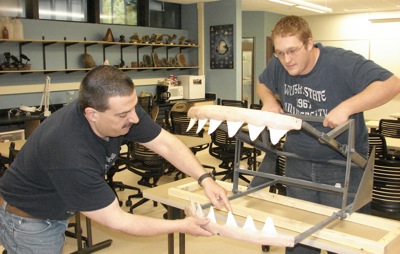Monday, April 27th, 2009
Professor works on TV special
By Janie Southard

Photo by Janie Southard/The Daily Standard
Professor Chuck Ciampaglio of Wright State University-Lake Campus was recruited as a consultant for a design team from California to build a shark jaw for a National Geographic special on Prehistoric Predators. Matt Overman, right, one of the students who assisted with the project, works on the jaw as Ciampaglio oversees. The other assistant was Bob Holthaus. The special airs at 10 p.m. Tuesday on the National Geographic channel.
The professor knows sharks. After Tuesday night, television viewers of the National Graphic Channel also will know the professor knows sharks including the controversy about the ancestry of the Great White.
One camp believes the Great White is a descendant of the Carcharodon megalodon, known as the giant megatooth shark. The other group believe it's a descendant of the mako shark.
An advocate of the mako theory, Chuck Ciampaglio, associate professor of geology at Wright State University-Lake Campus, caught the attention of the producers of National Geographic's Prehistoric Predators series about 18 months ago. They were intrigued with his paper "A Toothy Tale of Evolution: Convergence in Tooth Morphology Among Marine Mesozoi-Cenozoic Sharks, Reptiles and Mammals," which he wrote with Duke University's Gregory Wray.
In another research project, the two professors focused on the ancestry of the Great White Shark and its teeth. The National Geographic creative team were impressed with the duo's in-depth research and contacted Ciampaglio at the Lake Campus.
They asked Ciampaglia to build a replica of the megalodon jaw for their show "Prehistoric Predators: Monster Shark," which airs at 10 p.m. Tuesday on the National Geographic Channel. Ciampaglia will be narrating the segment of the jaw moving.
After creating the jaw replica, the professor and some of his students took on the task of making a block of material for the jaw to bite into. That material turned out to be made from strawberry gelatin.
"It was like a giant 'jigger.' We needed three cases of gelatin and strawberry was the only kind available in that quantity, but it turned out good because it gave good contrast," he said. "We used the school cafeteria and cooked the stuff up in three dish pans."
Creative Design in California, the group that puts together many of National Geographic's specials, had a lot of questions centered around the controversy of the Great White's ancestral line.
"I believe the Great White teeth look just like teeth from the mako shark except the Great White's are serrated," Ciampaglia said, turning in his hands the jawbone of a smaller shark. "In our studies, position for position in the jaws of the Great White and the mako, the teeth are identical. I think they are definitely descended from the mako."
But, the professor acknowledges most scientists would say the Great White evolved from the megalodon line of up to 20 million years ago. He says the megalodon were huge, about the size of a Greyhound bus with teeth up to six inches long.
So who is on the giant megatooth side? Well, many scientists, including Bob Purdy, collections manager for vertebrate paleontology at the Smithsonian Institution, who is steadfast with the megalodon even in the face of significant similarities between the Great White and the mako.
Does Ciampaglio think there could be concession on the Purdy-side of the issue?
"Actually, it seems a change of view on this type thing happens when someone retires and dies," he said without rancor.
And now for the big question: How much trouble did the production team have with the good professor's name.
"Well, I did get a lot of calls on pronunciation, but, as long as they spell it right, I'm okay," quipped Professor C-i-a-m-p-a-g-l-i-o.


